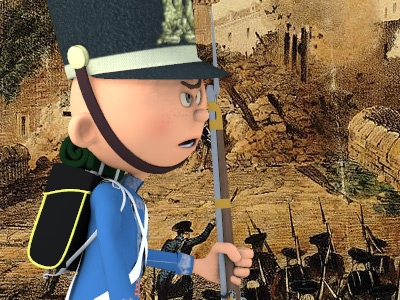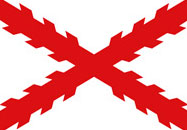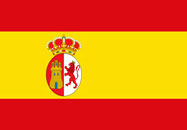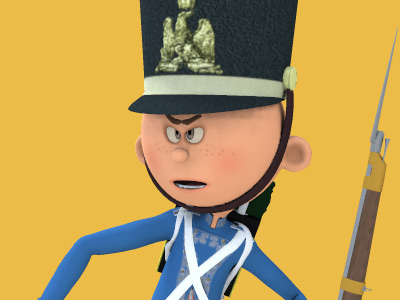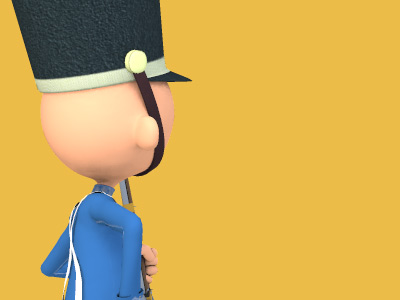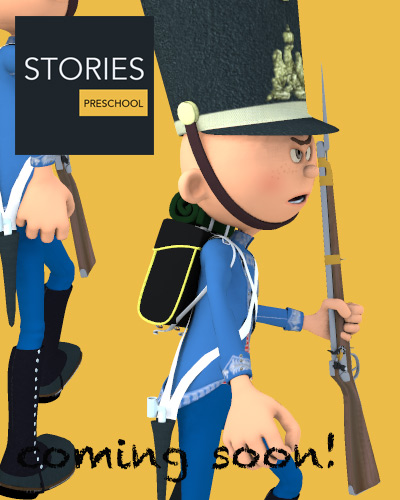First Carlist War (1833 to 1839)
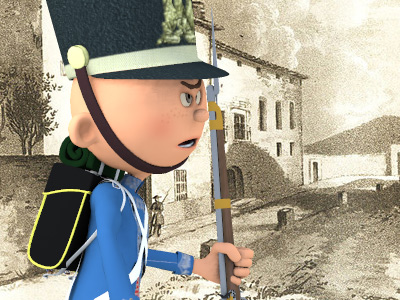
Basque Reasons for Carlist Uprising
Meanwhile, the Spanish courtiers wanted to suppress the Basque fueros and to move the customs borders to the Pyrenees. Since the 18th century, a new emergent class had an interest in weakening the powerful Basque nobles and their influence in commerce, including that extending throughout the world with the help of the Jesuit order.
The newly appointed Spanish courtiers supported some of the great powers against the Basques at least since the abolition of the Jesuit order and the Godoy regime. First they sided with the French Bourbons to suppress the Jesuits, following the formidable changes in North America after the victory of the United States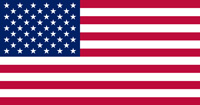 The United States of America (U.S.A. or USA), commonly known as the United States (U.S. or US) or America, is a country in North America. It is the world's third-largest country by both land and total area. The United States shares land borders with Canada to its north and with Mexico to its south. The national capital is Washington, D.C., and the most populous city and financial center is New York City. in the American Revolutionary War and the subsequent loss of Spanish influence. Then Godoy sided with the English against the Basques in the War of the Pyrenees of 1793, and immediately afterwards with the French of Napoleon
The United States of America (U.S.A. or USA), commonly known as the United States (U.S. or US) or America, is a country in North America. It is the world's third-largest country by both land and total area. The United States shares land borders with Canada to its north and with Mexico to its south. The national capital is Washington, D.C., and the most populous city and financial center is New York City. in the American Revolutionary War and the subsequent loss of Spanish influence. Then Godoy sided with the English against the Basques in the War of the Pyrenees of 1793, and immediately afterwards with the French of Napoleon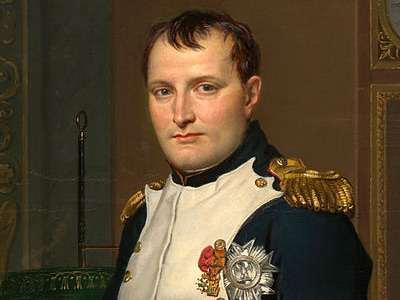 Napoleon Bonaparte (1769-1821), was a French military and political leader who rose to prominence during the French Revolution and led several successful campaigns during the French Revolutionary Wars. As Napoleon I, he was Emperor of the French from 1804 until 1814, and again in 1815. One of the greatest commanders in history, his wars and campaigns are studied at military schools worldwide. Napoleon Bonaparte », also against the Basques. The British
Napoleon Bonaparte (1769-1821), was a French military and political leader who rose to prominence during the French Revolution and led several successful campaigns during the French Revolutionary Wars. As Napoleon I, he was Emperor of the French from 1804 until 1814, and again in 1815. One of the greatest commanders in history, his wars and campaigns are studied at military schools worldwide. Napoleon Bonaparte », also against the Basques. The British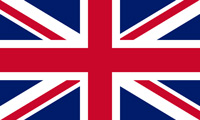 The United Kingdom of Great Britain and Ireland was a sovereign state in Northwestern Europe that comprised the entirety of the British Isles between 1801 and 1922. The United Kingdom, having financed the European coalition that defeated France during the Napoleonic Wars, developed a large Royal Navy that enabled the British Empire to become the foremost world power for the next century. interest was to destroy, for as long as possible, Spanish commercial routes and power, which were mainly sustained by the Basque ports and merchant fleet.
The United Kingdom of Great Britain and Ireland was a sovereign state in Northwestern Europe that comprised the entirety of the British Isles between 1801 and 1922. The United Kingdom, having financed the European coalition that defeated France during the Napoleonic Wars, developed a large Royal Navy that enabled the British Empire to become the foremost world power for the next century. interest was to destroy, for as long as possible, Spanish commercial routes and power, which were mainly sustained by the Basque ports and merchant fleet.

The Basque districts during the First Carlist War period

The Basque districts during the First Carlist War period
( Click image to enlarge)
King Ferdinand VII found an important support base in the Basque Country. The 1812 Constitution of Cádiz suppressed the Basque home rule, speaking of a unified Spanish nation and rejecting the existence of the Basque nation, so the new Spanish king garnered the endorsement of the Basques as long as he respected the Basque institutional and legal framework.
Charles F. Henningsen, Michael B. Honan, or Edward B. Stephens, English writers and first-hand witnesses of the First Carlist War, spent time in the Basque districts during the Carlist engagement. They did not hide their sympathies for Carlos V's cause, one they regarded as representing the cause of the Basque home rule. Just the opposite, John Francis Bacon, an English diplomat based in the Liberal Bilbao during the Carlist investment of the city (1835), while also praising Basque governance, could no hide his hostility towards the Carlists, whom he regarded as "savages." He went on to contest his compatriots' approach, denying any connections of the Carlist cause to the defense of the Basque liberties, and considering that Carlos V the pretender would be quick to erode or suppress them as soon as he rose to the Spanish throne. He also deems a Liberal government like the one led by Isabella II of Spain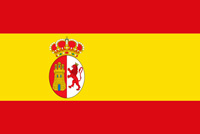 Spain or the Kingdom of Spain, is a country primarily located in southwestern Europe with parts of territory in the Atlantic Ocean and across the Mediterranean Sea. A major country of the Age of Discovery, Spain began the colonization of the New World in 1492 developing one of the largest empires in history and underpinned the emergence of a global trading system primarily fuelled by precious metals. as more inclined to respect the Basque liberties.
Spain or the Kingdom of Spain, is a country primarily located in southwestern Europe with parts of territory in the Atlantic Ocean and across the Mediterranean Sea. A major country of the Age of Discovery, Spain began the colonization of the New World in 1492 developing one of the largest empires in history and underpinned the emergence of a global trading system primarily fuelled by precious metals. as more inclined to respect the Basque liberties.

Zumalacárregui carried off after being injured (1835)
The privileges of the Basque provinces are odious to the Spanish nation, of which Charles is so well aware, that if he was king of Spain next year, he would quickly find excuses for infringing them, if not their total abolition. A representative government will endeavour to raise Spain to a level with the Basque provinces, – a despot, to whom the very name of freedom is odious, would strive to reduce the provinces to the same low level with the rest.
Similar to what John Adams had pointed 60 years before, John F. Bacon (Six years in Biscay..., 1838) considers the Basques living to the north of the Ebro river as free citizens, as compared to the Spanish whom he sees as "a mere flock" liable to be mistreated by their masters. For Edward B. Stephens, the Basques were fighting at once for their own sources of legitimacy, their practical freedom, for the rights of their sovereign, and their own constitutional foundations. The excellence of the Basque home rule and its republican character is also highlighted by other authors, such as Wentworth Webster. A deeper insight into the Basques and their relation to the Spanish during this period is offered by Sidney Crocker and Bligh Barker (1839), stating that:
the Vasques, or as they term themselves, the Escaldunes, do not consider themselves Spaniards, and differ widely from them, in character and language.
The interests of the Basque liberals were divided. On the one side, fluent cross-Pyrenean trade with other Basque districts and France The July Monarchy, officially the Kingdom of France, was a liberal constitutional monarchy in France under Louis Philippe I, starting on 26 July 1830, with the July Revolution of 1830, and ending 23 February 1848, with the Revolution of 1848. It marks the end of the Bourbon Restoration (1814–1830). It began with the overthrow of the conservative government of Charles X, the last king of the House of Bourbon. was highly valued, as well as unrestricted overseas transactions. The former had been strong up to the French Revolution, especially in Navarre, but the new French national arrangement (1790) had abolished the separate legal and fiscal status of the French Basque districts. Despite difficulties, on-off trade continued during the period of uncertainty prevailing under the French Convention, the War of the Pyrenees (1793-1795), Manuel Godoy's tenure in office, and the Peninsular War. Eventually, Napoleonic defeat left cross-border commercial activity struggling to take off after 1813.
The July Monarchy, officially the Kingdom of France, was a liberal constitutional monarchy in France under Louis Philippe I, starting on 26 July 1830, with the July Revolution of 1830, and ending 23 February 1848, with the Revolution of 1848. It marks the end of the Bourbon Restoration (1814–1830). It began with the overthrow of the conservative government of Charles X, the last king of the House of Bourbon. was highly valued, as well as unrestricted overseas transactions. The former had been strong up to the French Revolution, especially in Navarre, but the new French national arrangement (1790) had abolished the separate legal and fiscal status of the French Basque districts. Despite difficulties, on-off trade continued during the period of uncertainty prevailing under the French Convention, the War of the Pyrenees (1793-1795), Manuel Godoy's tenure in office, and the Peninsular War. Eventually, Napoleonic defeat left cross-border commercial activity struggling to take off after 1813.
Overseas commerce was badly affected by the end of the Guipuzcoan Company of Caracas (1785), the French-Spanish defeat at the Battle of Trafalgar (1805), independence movements in Latin America, the destruction of San Sebastián (1813), and the eventual breakup of the Royal Philippine Company (1814). By 1826 all the grand Spanish (including the Basque) fleet of the late 18th century with its renowned Basque navigators was gone for the benefit of the British Empire, and with it, the Atlantic vocation of the Enlightened Spain.
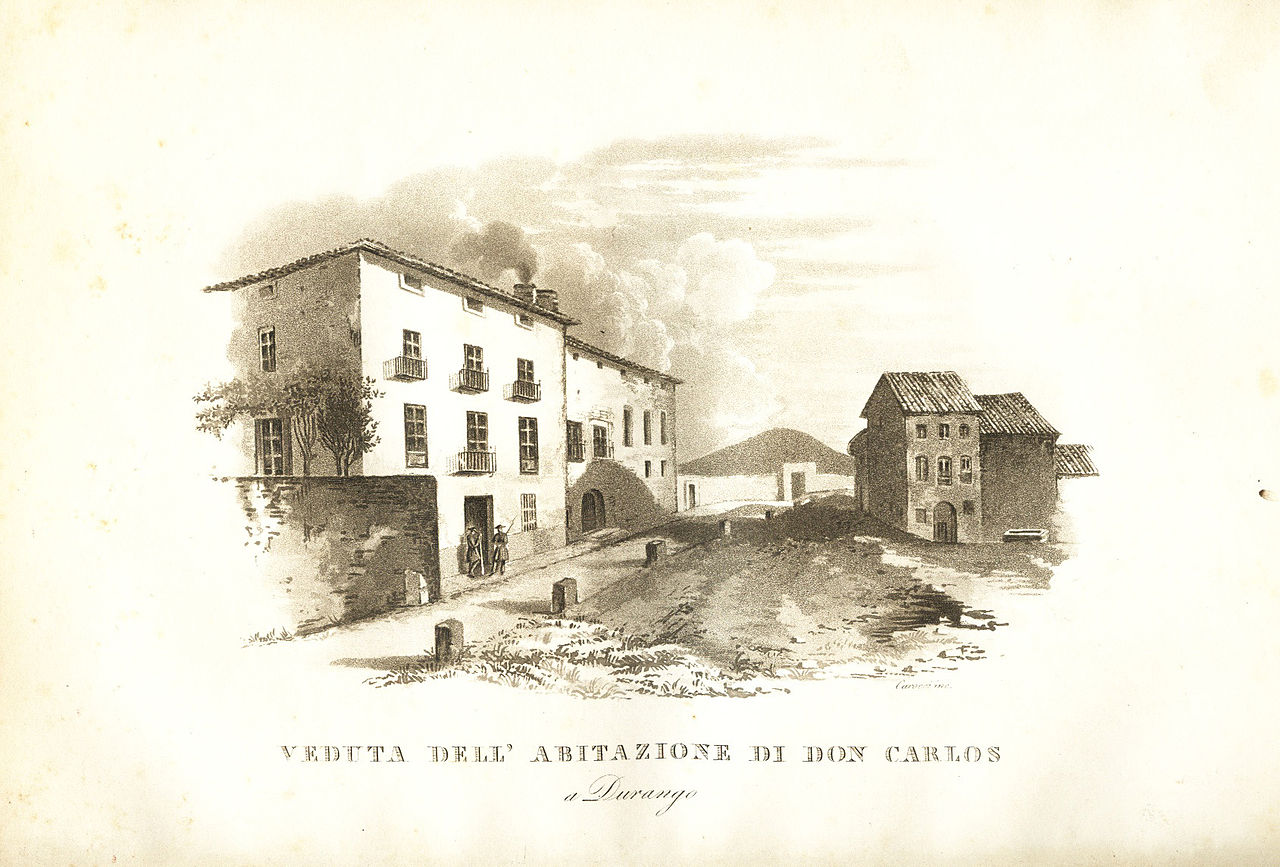
Carlos' seat at Durango in 1837

Carlos' seat at Durango in 1837
( Click image to enlarge)
Notwithstanding the ideology of Basque liberals, overall supportive of home rule, the Basques were getting choked by the above circumstances and customs on the Ebro, on account of the high levies enforced on them by the successive Spanish governments after 1776. Many Basque liberals advocated in turn for the relocation of the Ebro customs to the Pyrenees, and the encouragement of a Spanish market.
On Ferdinand VII's death in 1833, the minor Isabella II was proclaimed queen, with Maria Christina acting as regent. In November, a new Spanish institutional arrangement was designed by the incoming government in Madrid, homogenising Spanish administration according to provinces and conspicuously overruling Basque institutions. Anger and disbelief spread in the Basque districts.
HISTORY
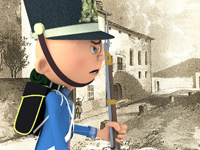
RESOURCES
This article uses material from the Wikipedia article "First Carlist War", which is released under the Creative Commons Attribution-Share-Alike License 3.0.
© Stories Preschool. All Rights Reserved.
